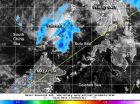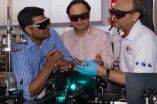(Press-News.org) An international team of scientists that included USC's Meghan Miller used computer modeling to reveal, for the first time, how giant swirls form during the collision of tectonic plates – with subduction zones stuttering and recovering after continental fragments slam into them.
The team's 3D models suggest a likely answer to a question that has long plagued geologists: why do long, curving mountain chains form along some subduction zones – where two tectonic plates collide, pushing one down into the mantle?
Based on the models, the researchers found that parts of the slab that is being subducted sweep around behind the collision, pushing continental material into the mountain belt.
With predictions confirmed by field observations, the 3D models show a characteristic pattern of intense localized heating, volcanic activity and fresh sediments that remained enigmatic until now.
"The new model explains why we see curved mountains near colliding plates, where material that has been scraped off of one plate and accreted on another is dragged into a curved path on the continent," Miller said.
Miller collaborated with lead author Louis Moresi from Monash University and his colleagues Peter Betts (also from Monash) and R. A. Cayley from the Geological Survey of Victoria in Australia. Their research was published online by Nature on March 23.
Their research specifically looked at the ancient geologic record of Eastern Australia, but is also applicable to the Pacific Northwest of the United States, the Mediterranean, and southeast Asia. Coastal mountain ranges from Northern California up to Alaska were formed by the scraping off of fragment of the ancient Farallon plate as it subducted beneath the North American continent. The geology of the Western Cordillera (wide mountain belts that extend along all of North America) fits the predictions of the computer model.
"The amazing thing about this research is that we can now interpret arcuate-shaped geological structures on the continents in a whole new way," Miller said. "We no longer need to envision complex motions and geometries to explain the origins of ancient or modern curved mountain belts."
The new results from this research will help geologists interpret the formation of ancient mountain belts and may prove most useful as a template to interpret regions where preservation of evidence for past collisions is incomplete - a common, and often frustrating, challenge for geologists working in fragmented ancient terrains.
INFORMATION:
Moresi was funded by the Australian Research Council and Miller was funded by NSF CAREER award.
Computer models solve geologic riddle millions of years in the making
New study provides explanation for long-debated origin of bow-shaped mountain belts that form along the edges of colliding tectonic plates
2014-03-24
ELSE PRESS RELEASES FROM THIS DATE:
Motor learning: Lining up our sights
2014-03-24
Neurologists at Ludwig-Maximilians-Universitaet (LMU) in Munich have studied the role of the vestibular system, which controls balance, in optimizing how we direct our gaze. The results could lead to more effective rehabilitation of patients with vestibular or cerebellar dysfunction.
When we shift the direction of our gaze, head and eye movements are normally highly coordinated with each other. Indeed, from the many possible combinations of speed and duration for such movements, the brain chooses the one that minimizes the error in reaching the intended line of sight. ...
Glatt Kosher for Passover Seders At Talia's Steakhouse & Bar, A Manhattan Kosher Restaurant - Chol Hamoed and Yom Tov Meals Are Also Available at Talia's During This Popular Jewish Holiday
2014-03-24
If you are looking for a relaxing and stress-free way to celebrate Passover with your loved ones without spending the whole day in the kitchen, consider what has become a tradition for Passover at the popular New York City Glatt Kosher restaurant, Talia's Steakhouse & Bar, located on the Upper West Side of Manhattan, NYC.
For over eleven years, Talia's Steakhouse & Bar has been serving the kosher community of the NY Metro area. As the premier Glatt kosher establishment in Manhattan, Talia's is proud to announce that, once again, it will conduct four prepaid ...
Leukemia caused by chromosome catastrophe
2014-03-24
Researchers have found that people born with a rare abnormality of their chromosomes have a 2,700-fold increased risk of a rare childhood leukaemia. In this abnormality, two specific chromosomes are fused together but become prone to catastrophic shattering.
Acute lymphoblastic leukaemia, or ALL, is the most common childhood cancer. Scientists previously found that a small subset of ALL patients have repeated sections of chromosome 21 in the genomes of their leukaemia cells. This form of ALL – iAMP21 ALL – requires more intensive treatment than many other types of ALL. ...
Small number of counties leads the way in reducing smoking rates in the US
2014-03-24
SEATTLE — Nationally, smoking rates have decreased since 1996, but the declines have been driven by a relatively small share of counties across the US, according to new research from the Institute for Health Metrics and Evaluation (IHME) at the University of Washington.
The study, "Cigarette smoking prevalence in US counties: 1996-2012," was published March 24 in the open-access, peer-reviewed journal Population Health Metrics.
Total cigarette smoking prevalence – the percentage of the population that smokes – has not decreased significantly in all counties but, because ...
Increased awareness about skin cancer needed for minorities
2014-03-24
DETROIT – More awareness about skin cancer is needed for minorities because they believe they are at low risk of developing it, says Henry Ford Hospital dermatologist Diane Jackson-Richards, M.D.
Research has shown that minorities are diagnosed at a more advanced stage of skin cancer and have lower chances of survival than Caucasians. Squamous cell carcinoma is the most common skin cancer among African Americans and Asian Indians, and the second most common skin cancer in Hispanics, East Asians and Caucasians, according to the Skin Cancer Foundation.
"We need to intensify ...
Researchers improve performance of III-V nanowire solar cells on graphene
2014-03-24
Imagine a field of small wires—standing at attention like a tiny field of wheat—gathering the Sun's rays as the first step in solar energy conversion.
Researchers at the University of Illinois at Urbana-Champaign have achieved new levels of performance for seed-free and substrate-free arrays of nanowires from class of materials called III-V (three-five) directly on graphene. These compound semiconductors hold particular promise for applications involving light, such as solar cells or lasers.
"Over the past two decades, research in the field of semiconductor nanowires ...
NASA sees Tropical Depression 04W's remnants affecting Palawan
2014-03-24
Tropical Depression 04W formed in the Northwestern Pacific Ocean on March 23 and marched across the southern Philippines. NASA's TRMM satellite spotted moderate rainfall occurring near Palawan the next day from the storm's remnants.
Formerly known as System 94W, the tropical low organized into Tropical Depression 04W (TD04W) on Sunday, March 23. TD04W then crossed through the southern and central Philippines on March 22 and 23, moving from east to west through Mindanao and Visayas. At 04:32 UTC/12:32 a.m. EDT the depression had maximum sustained winds near 20 knots/23.0 ...
World's first light-activated antimicrobial surface that also works in the dark
2014-03-24
Researchers at UCL have developed a new antibacterial material which has potential for cutting hospital acquired infections. The combination of two simple dyes with nanoscopic particles of gold is deadly to bacteria when activated by light - even under modest indoor lighting. And in a first for this type of substance, it also shows impressive antibacterial properties in total darkness.
The research, from by Sacha Noimark and Ivan Parkin (both UCL Chemistry) and Elaine Allan (UCL Eastman Dental Institute), is published today in the journal Chemical Science.
Hospital-acquired ...
NTU scientists discover material that can be solar cell by day, light panel by night
2014-03-24
In future, when your mobile or tablet runs out of battery, you could just recharge it by putting it out in the sun.
Nanyang Technological University (NTU) scientists have developed a next-generation solar cell material which can also emit light, in addition to converting light to electricity.
This solar cell is developed from Perovskite, a promising material that could hold the key to creating high-efficiency, inexpensive solar cells. The new cells not only glow when electricity passes through them, but they can also be customised to emit different colours.
Picture ...
'RoboClam' replicates a clam's ability to burrow while using little energy
2014-03-24
The Atlantic razor clam uses very little energy to burrow into undersea soil at high speed. Now a detailed insight into how the animal digs has led to the development of a robotic clam that can perform the same trick.
The device, known as "RoboClam," could be used to dig itself into the ground to bury anchors or destroy underwater mines, according to its developer, Amos Winter, the Robert N. Noyce Career Development Assistant Professor of Mechanical Engineering at MIT.
Despite its rigid shell, the Atlantic razor clam (Ensis directus) can move through soil at a speed ...
LAST 30 PRESS RELEASES:
New software sheds light on cancer’s hidden genetic networks
UT Health San Antonio awarded $3 million in CPRIT grants to bolster cancer research and prevention efforts in South Texas
Third symposium spotlights global challenge of new contaminants in China’s fight against pollution
From straw to soil harmony: International team reveals how biochar supercharges carbon-smart farming
Myeloma: How AI is redrawing the map of cancer care
Manhattan E. Charurat, Ph.D., MHS invested as the Homer and Martha Gudelsky Distinguished Professor in Medicine at the University of Maryland School of Medicine
Insilico Medicine’s Pharma.AI Q4 Winter Launch Recap: Revolutionizing drug discovery with cutting-edge AI innovations, accelerating the path to pharmaceutical superintelligence
Nanoplastics have diet-dependent impacts on digestive system health
Brain neuron death occurs throughout life and increases with age, a natural human protein drug may halt neuron death in Alzheimer’s disease
SPIE and CLP announce the recipients of the 2025 Advanced Photonics Young Innovator Award
Lessons from the Caldor Fire’s Christmas Valley ‘Miracle’
Ant societies rose by trading individual protection for collective power
Research reveals how ancient viral DNA shapes early embryonic development
A molecular gatekeeper that controls protein synthesis
New ‘cloaking device’ concept to shield sensitive tech from magnetic fields
Researchers show impact of mountain building and climate change on alpine biodiversity
Study models the transition from Neanderthals to modern humans in Europe
University of Phoenix College of Doctoral Studies releases white paper on AI-driven skilling to reduce burnout and restore worker autonomy
AIs fail at the game of visual “telephone”
The levers for a sustainable food system
Potential changes in US homelessness by ending federal support for housing first programs
Vulnerability of large language models to prompt injection when providing medical advice
Researchers develop new system for high-energy-density, long-life, multi-electron transfer bromine-based flow batteries
Ending federal support for housing first programs could increase U.S. homelessness by 5% in one year, new JAMA study finds
New research uncovers molecular ‘safety switch’ shielding cancers from immune attack
Bacteria resisting viral infection can still sink carbon to ocean floor
Younger biological age may increase depression risk in older women during COVID-19
Bharat Innovates 2026 National Basecamp Showcases India’s Most Promising Deep-Tech Ventures
Here’s what determines whether your income level rises or falls
SCIE indexation achievement: Celebrate with Space: Science & Technology
[Press-News.org] Computer models solve geologic riddle millions of years in the makingNew study provides explanation for long-debated origin of bow-shaped mountain belts that form along the edges of colliding tectonic plates





